Detailed Analysis of Management Accounting Costing Methods Assignment
VerifiedAdded on 2019/11/25
|6
|868
|143
Homework Assignment
AI Summary
This assignment delves into management accounting, specifically comparing and contrasting activity-based costing (ABC) with traditional costing methods. It includes a detailed calculation of product cost per unit for two products, Fred and Martha, under ABC, demonstrating the allocation of overhead costs based on various activities like machine hours, setup, and engineering. The assignment highlights the mispricing issues that can arise from conventional overhead allocation, which relies on a single cost driver, and presents the advantages of ABC, such as improved business processes, identification of wasteful products, and enhanced cost management. It emphasizes how ABC helps in resource allocation, pricing strategies, and continuous business procedure improvement. The document references academic sources to support its analysis.
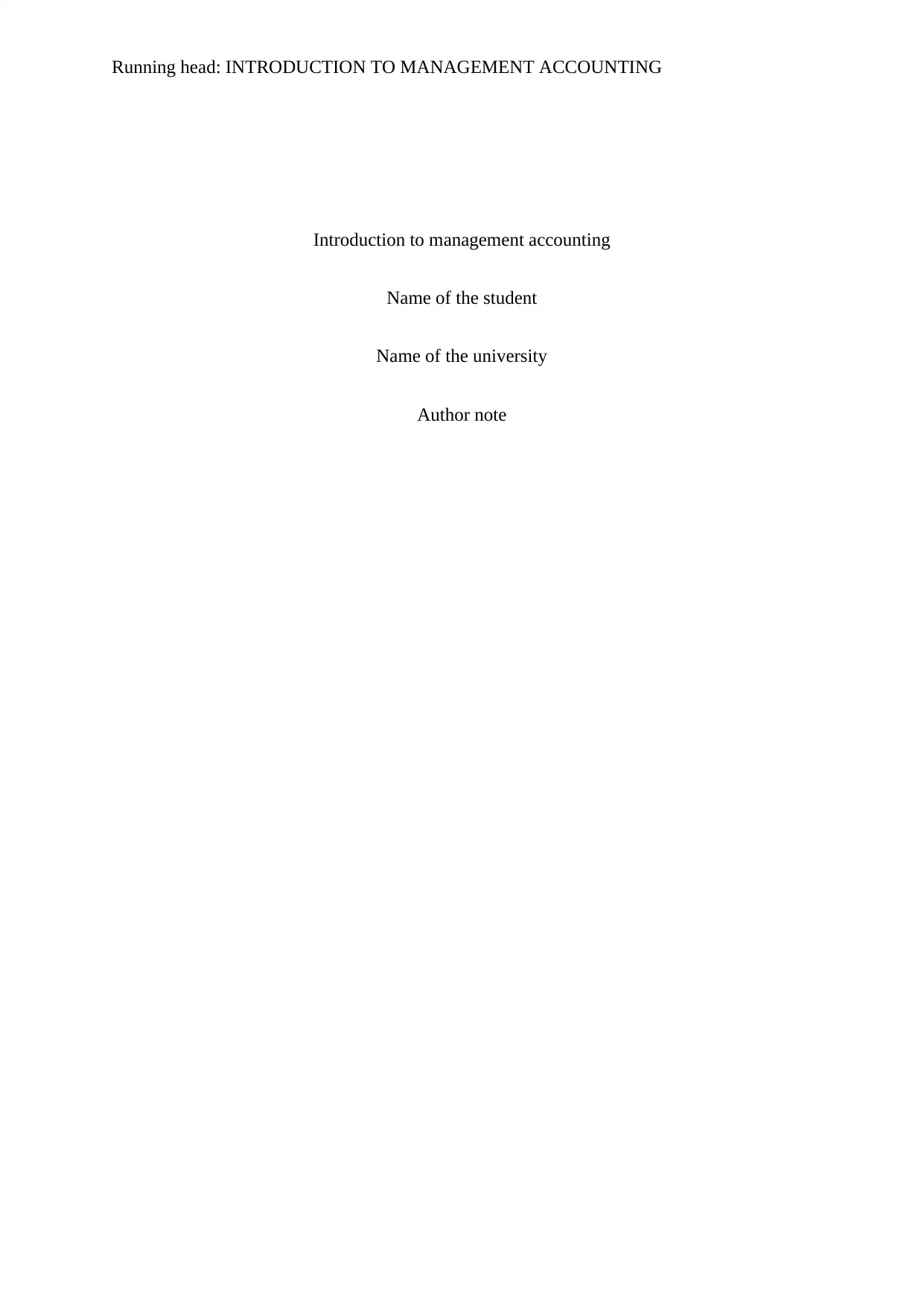
Running head: INTRODUCTION TO MANAGEMENT ACCOUNTING
Introduction to management accounting
Name of the student
Name of the university
Author note
Introduction to management accounting
Name of the student
Name of the university
Author note
Paraphrase This Document
Need a fresh take? Get an instant paraphrase of this document with our AI Paraphraser
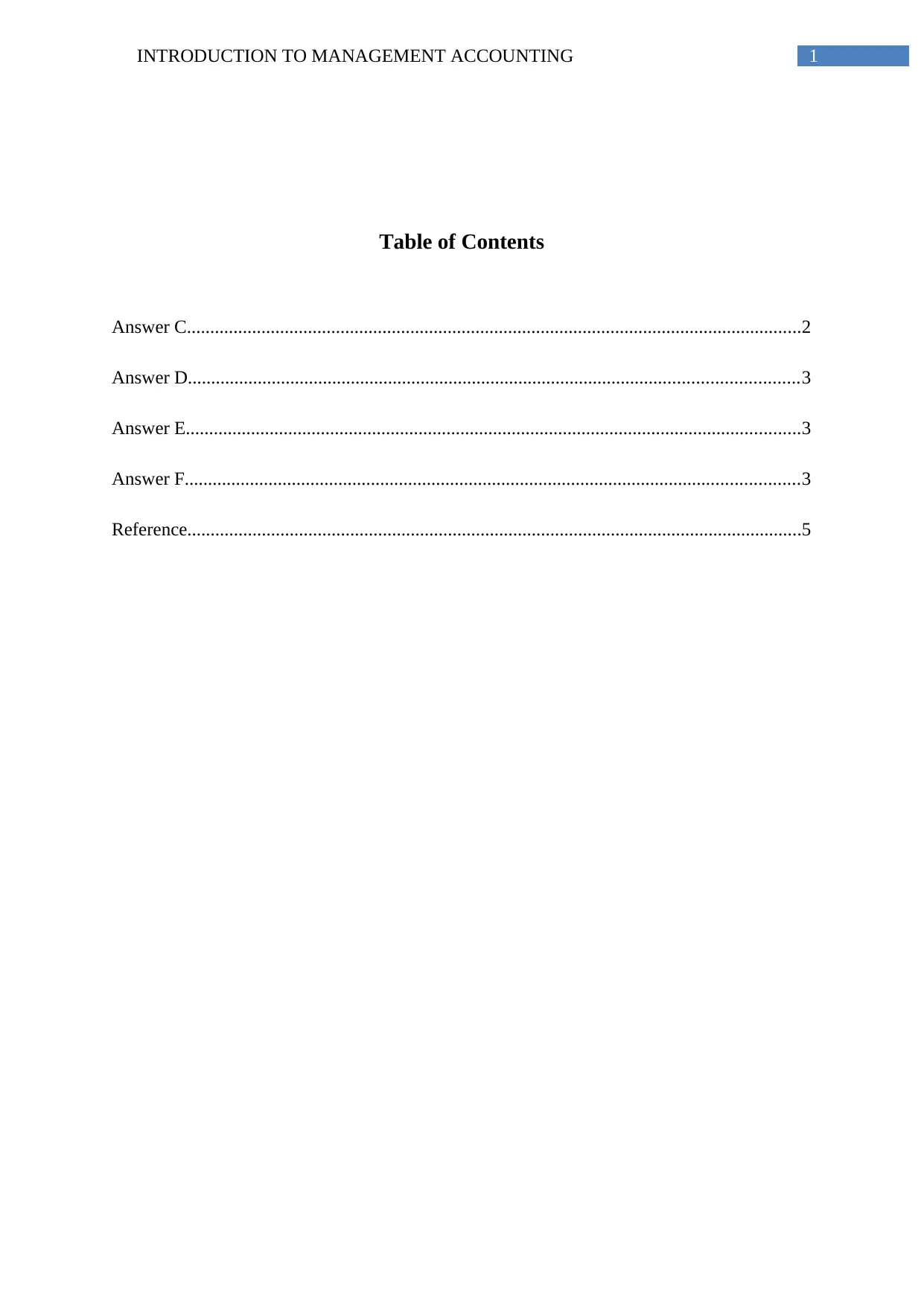
1INTRODUCTION TO MANAGEMENT ACCOUNTING
Table of Contents
Answer C....................................................................................................................................2
Answer D...................................................................................................................................3
Answer E....................................................................................................................................3
Answer F....................................................................................................................................3
Reference....................................................................................................................................5
Table of Contents
Answer C....................................................................................................................................2
Answer D...................................................................................................................................3
Answer E....................................................................................................................................3
Answer F....................................................................................................................................3
Reference....................................................................................................................................5
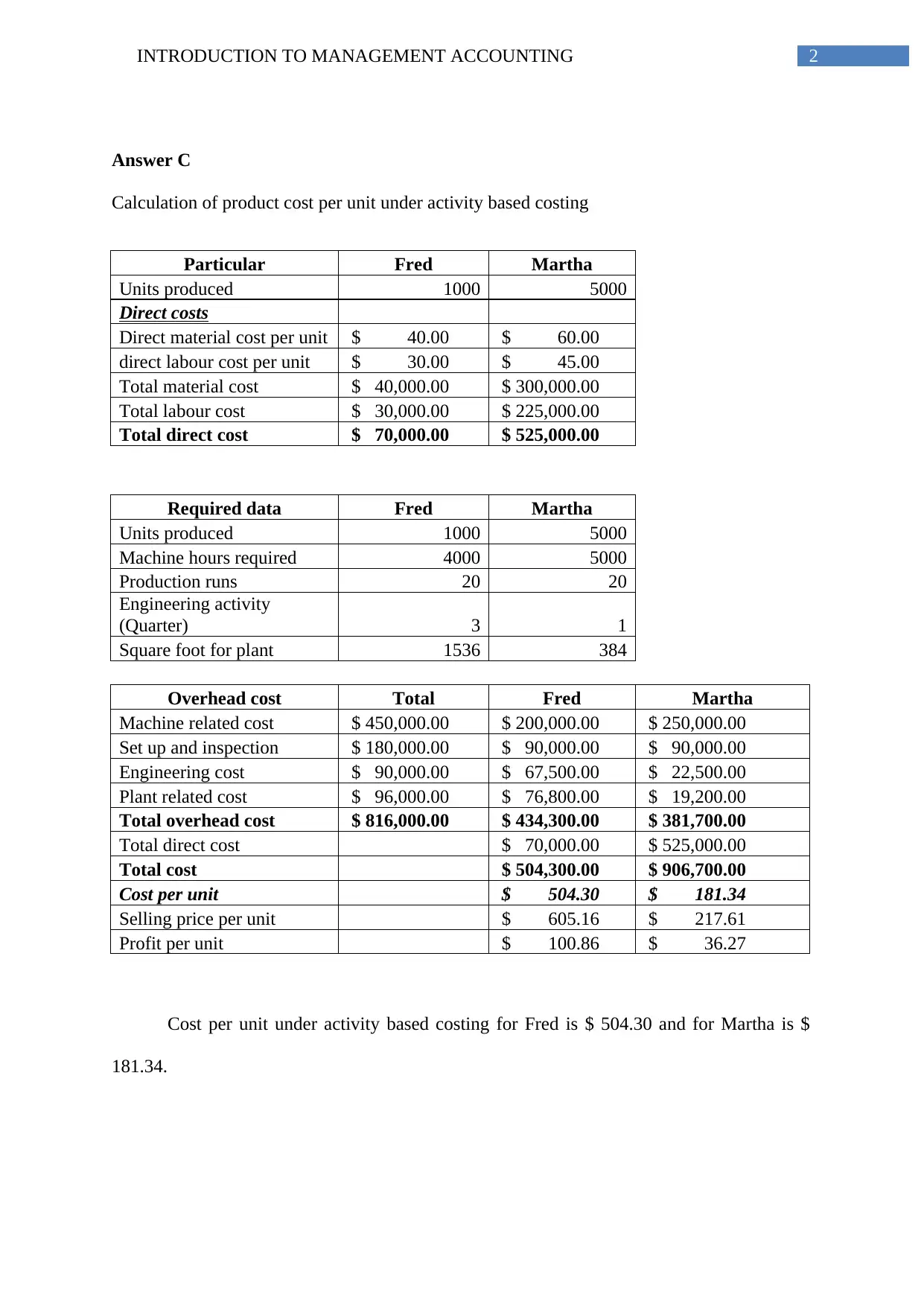
2INTRODUCTION TO MANAGEMENT ACCOUNTING
Answer C
Calculation of product cost per unit under activity based costing
Particular Fred Martha
Units produced 1000 5000
Direct costs
Direct material cost per unit $ 40.00 $ 60.00
direct labour cost per unit $ 30.00 $ 45.00
Total material cost $ 40,000.00 $ 300,000.00
Total labour cost $ 30,000.00 $ 225,000.00
Total direct cost $ 70,000.00 $ 525,000.00
Required data Fred Martha
Units produced 1000 5000
Machine hours required 4000 5000
Production runs 20 20
Engineering activity
(Quarter) 3 1
Square foot for plant 1536 384
Overhead cost Total Fred Martha
Machine related cost $ 450,000.00 $ 200,000.00 $ 250,000.00
Set up and inspection $ 180,000.00 $ 90,000.00 $ 90,000.00
Engineering cost $ 90,000.00 $ 67,500.00 $ 22,500.00
Plant related cost $ 96,000.00 $ 76,800.00 $ 19,200.00
Total overhead cost $ 816,000.00 $ 434,300.00 $ 381,700.00
Total direct cost $ 70,000.00 $ 525,000.00
Total cost $ 504,300.00 $ 906,700.00
Cost per unit $ 504.30 $ 181.34
Selling price per unit $ 605.16 $ 217.61
Profit per unit $ 100.86 $ 36.27
Cost per unit under activity based costing for Fred is $ 504.30 and for Martha is $
181.34.
Answer C
Calculation of product cost per unit under activity based costing
Particular Fred Martha
Units produced 1000 5000
Direct costs
Direct material cost per unit $ 40.00 $ 60.00
direct labour cost per unit $ 30.00 $ 45.00
Total material cost $ 40,000.00 $ 300,000.00
Total labour cost $ 30,000.00 $ 225,000.00
Total direct cost $ 70,000.00 $ 525,000.00
Required data Fred Martha
Units produced 1000 5000
Machine hours required 4000 5000
Production runs 20 20
Engineering activity
(Quarter) 3 1
Square foot for plant 1536 384
Overhead cost Total Fred Martha
Machine related cost $ 450,000.00 $ 200,000.00 $ 250,000.00
Set up and inspection $ 180,000.00 $ 90,000.00 $ 90,000.00
Engineering cost $ 90,000.00 $ 67,500.00 $ 22,500.00
Plant related cost $ 96,000.00 $ 76,800.00 $ 19,200.00
Total overhead cost $ 816,000.00 $ 434,300.00 $ 381,700.00
Total direct cost $ 70,000.00 $ 525,000.00
Total cost $ 504,300.00 $ 906,700.00
Cost per unit $ 504.30 $ 181.34
Selling price per unit $ 605.16 $ 217.61
Profit per unit $ 100.86 $ 36.27
Cost per unit under activity based costing for Fred is $ 504.30 and for Martha is $
181.34.
⊘ This is a preview!⊘
Do you want full access?
Subscribe today to unlock all pages.

Trusted by 1+ million students worldwide
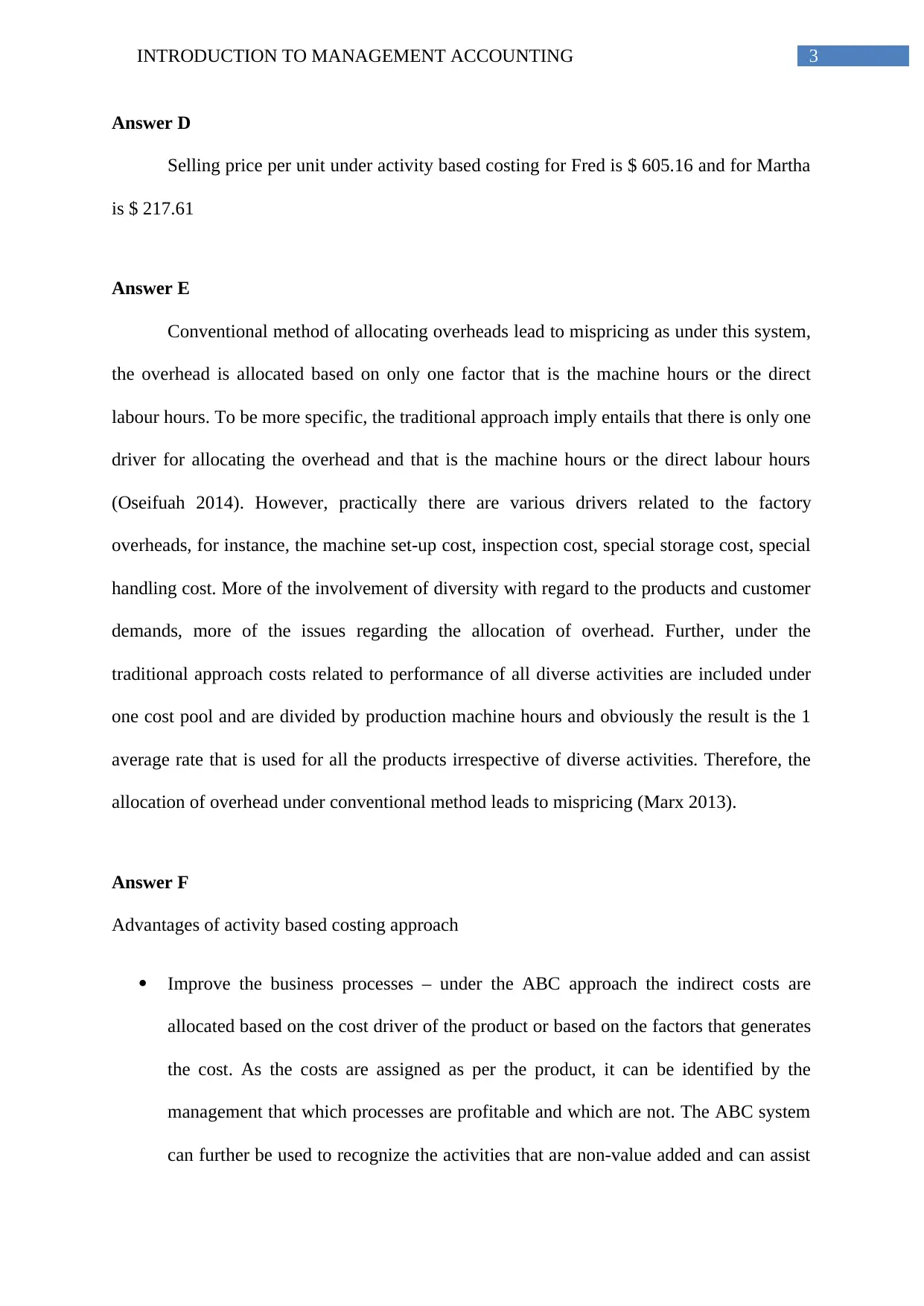
3INTRODUCTION TO MANAGEMENT ACCOUNTING
Answer D
Selling price per unit under activity based costing for Fred is $ 605.16 and for Martha
is $ 217.61
Answer E
Conventional method of allocating overheads lead to mispricing as under this system,
the overhead is allocated based on only one factor that is the machine hours or the direct
labour hours. To be more specific, the traditional approach imply entails that there is only one
driver for allocating the overhead and that is the machine hours or the direct labour hours
(Oseifuah 2014). However, practically there are various drivers related to the factory
overheads, for instance, the machine set-up cost, inspection cost, special storage cost, special
handling cost. More of the involvement of diversity with regard to the products and customer
demands, more of the issues regarding the allocation of overhead. Further, under the
traditional approach costs related to performance of all diverse activities are included under
one cost pool and are divided by production machine hours and obviously the result is the 1
average rate that is used for all the products irrespective of diverse activities. Therefore, the
allocation of overhead under conventional method leads to mispricing (Marx 2013).
Answer F
Advantages of activity based costing approach
Improve the business processes – under the ABC approach the indirect costs are
allocated based on the cost driver of the product or based on the factors that generates
the cost. As the costs are assigned as per the product, it can be identified by the
management that which processes are profitable and which are not. The ABC system
can further be used to recognize the activities that are non-value added and can assist
Answer D
Selling price per unit under activity based costing for Fred is $ 605.16 and for Martha
is $ 217.61
Answer E
Conventional method of allocating overheads lead to mispricing as under this system,
the overhead is allocated based on only one factor that is the machine hours or the direct
labour hours. To be more specific, the traditional approach imply entails that there is only one
driver for allocating the overhead and that is the machine hours or the direct labour hours
(Oseifuah 2014). However, practically there are various drivers related to the factory
overheads, for instance, the machine set-up cost, inspection cost, special storage cost, special
handling cost. More of the involvement of diversity with regard to the products and customer
demands, more of the issues regarding the allocation of overhead. Further, under the
traditional approach costs related to performance of all diverse activities are included under
one cost pool and are divided by production machine hours and obviously the result is the 1
average rate that is used for all the products irrespective of diverse activities. Therefore, the
allocation of overhead under conventional method leads to mispricing (Marx 2013).
Answer F
Advantages of activity based costing approach
Improve the business processes – under the ABC approach the indirect costs are
allocated based on the cost driver of the product or based on the factors that generates
the cost. As the costs are assigned as per the product, it can be identified by the
management that which processes are profitable and which are not. The ABC system
can further be used to recognize the activities that are non-value added and can assist
Paraphrase This Document
Need a fresh take? Get an instant paraphrase of this document with our AI Paraphraser
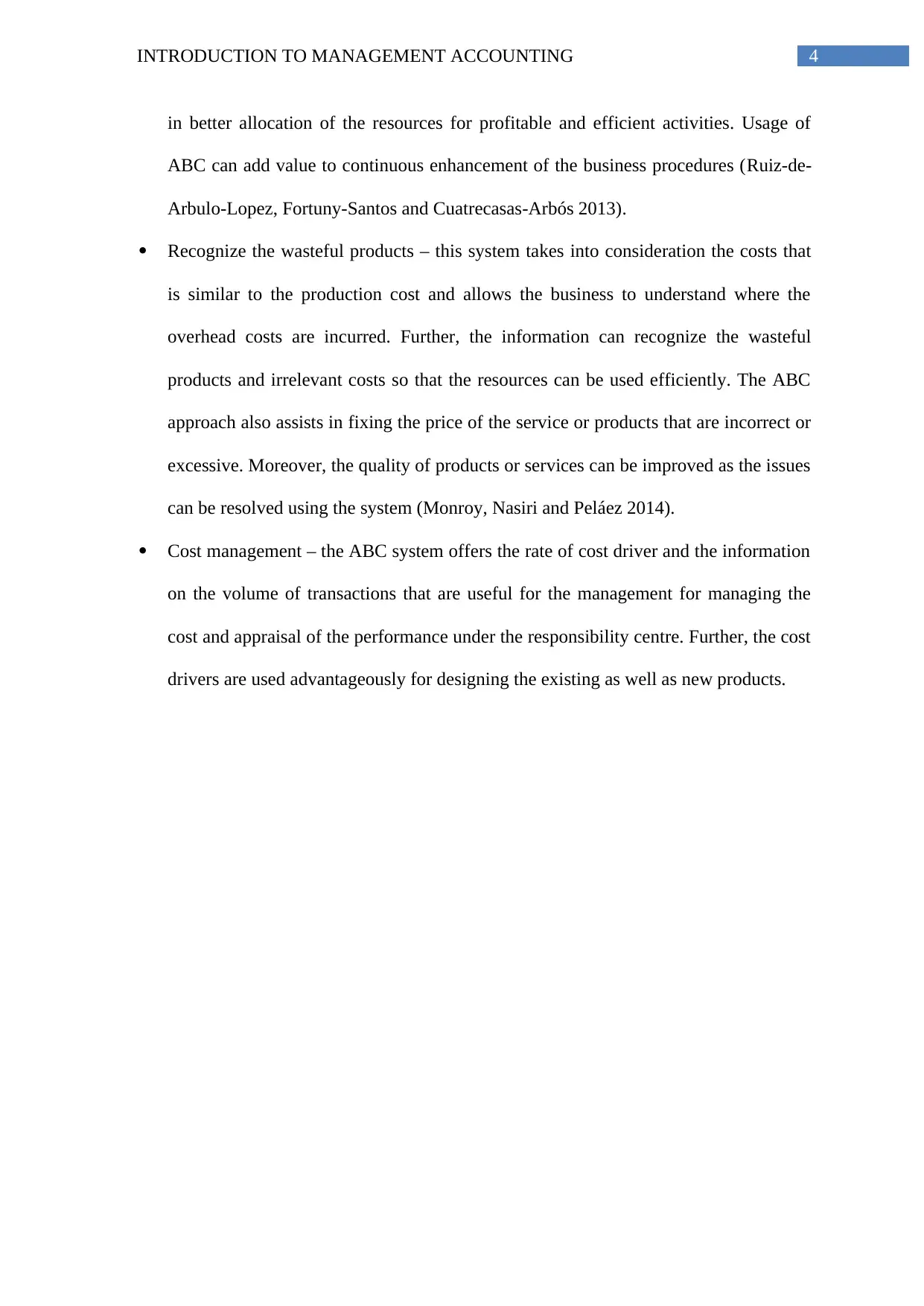
4INTRODUCTION TO MANAGEMENT ACCOUNTING
in better allocation of the resources for profitable and efficient activities. Usage of
ABC can add value to continuous enhancement of the business procedures (Ruiz-de-
Arbulo-Lopez, Fortuny-Santos and Cuatrecasas-Arbós 2013).
Recognize the wasteful products – this system takes into consideration the costs that
is similar to the production cost and allows the business to understand where the
overhead costs are incurred. Further, the information can recognize the wasteful
products and irrelevant costs so that the resources can be used efficiently. The ABC
approach also assists in fixing the price of the service or products that are incorrect or
excessive. Moreover, the quality of products or services can be improved as the issues
can be resolved using the system (Monroy, Nasiri and Peláez 2014).
Cost management – the ABC system offers the rate of cost driver and the information
on the volume of transactions that are useful for the management for managing the
cost and appraisal of the performance under the responsibility centre. Further, the cost
drivers are used advantageously for designing the existing as well as new products.
in better allocation of the resources for profitable and efficient activities. Usage of
ABC can add value to continuous enhancement of the business procedures (Ruiz-de-
Arbulo-Lopez, Fortuny-Santos and Cuatrecasas-Arbós 2013).
Recognize the wasteful products – this system takes into consideration the costs that
is similar to the production cost and allows the business to understand where the
overhead costs are incurred. Further, the information can recognize the wasteful
products and irrelevant costs so that the resources can be used efficiently. The ABC
approach also assists in fixing the price of the service or products that are incorrect or
excessive. Moreover, the quality of products or services can be improved as the issues
can be resolved using the system (Monroy, Nasiri and Peláez 2014).
Cost management – the ABC system offers the rate of cost driver and the information
on the volume of transactions that are useful for the management for managing the
cost and appraisal of the performance under the responsibility centre. Further, the cost
drivers are used advantageously for designing the existing as well as new products.
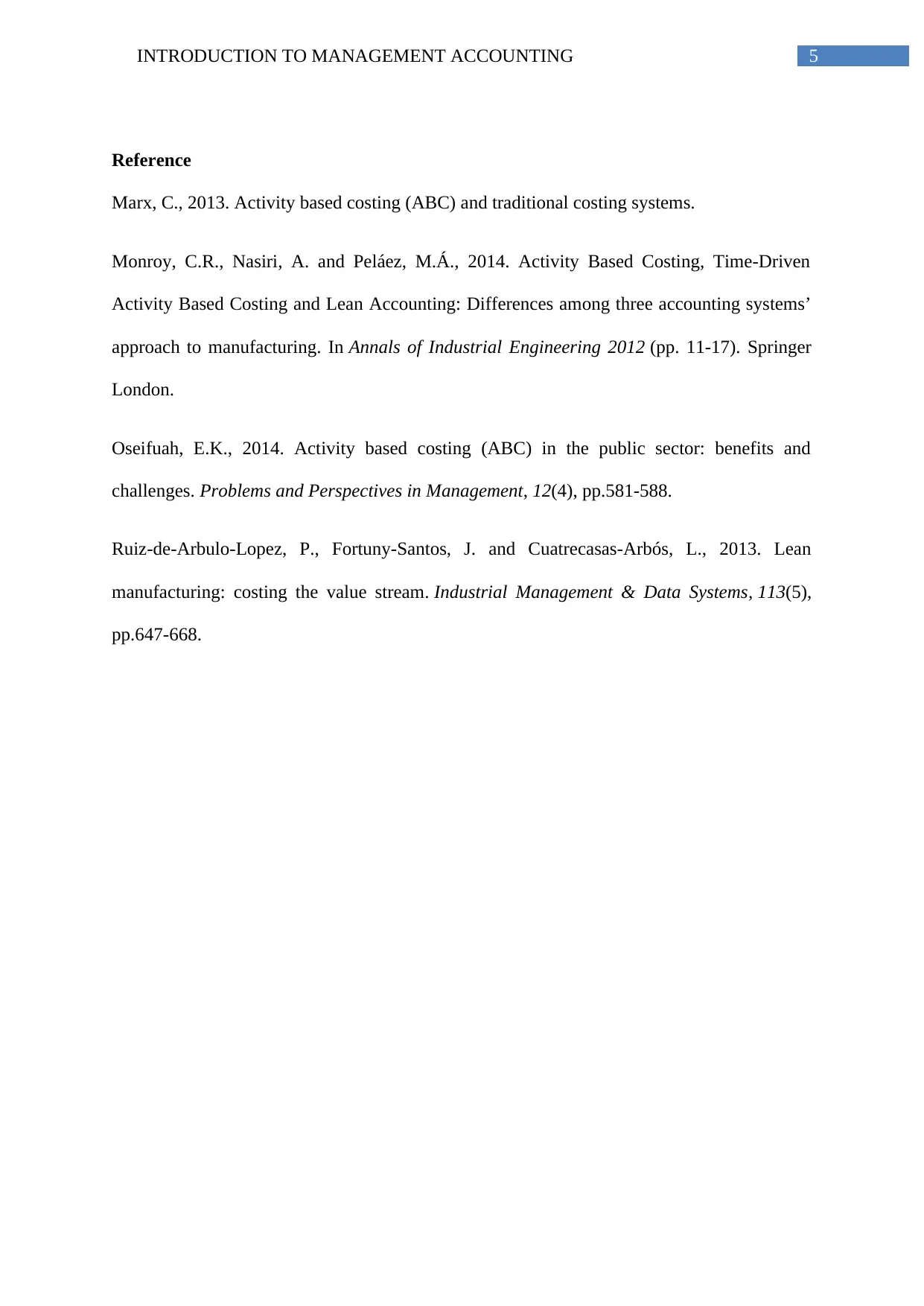
5INTRODUCTION TO MANAGEMENT ACCOUNTING
Reference
Marx, C., 2013. Activity based costing (ABC) and traditional costing systems.
Monroy, C.R., Nasiri, A. and Peláez, M.Á., 2014. Activity Based Costing, Time-Driven
Activity Based Costing and Lean Accounting: Differences among three accounting systems’
approach to manufacturing. In Annals of Industrial Engineering 2012 (pp. 11-17). Springer
London.
Oseifuah, E.K., 2014. Activity based costing (ABC) in the public sector: benefits and
challenges. Problems and Perspectives in Management, 12(4), pp.581-588.
Ruiz-de-Arbulo-Lopez, P., Fortuny-Santos, J. and Cuatrecasas-Arbós, L., 2013. Lean
manufacturing: costing the value stream. Industrial Management & Data Systems, 113(5),
pp.647-668.
Reference
Marx, C., 2013. Activity based costing (ABC) and traditional costing systems.
Monroy, C.R., Nasiri, A. and Peláez, M.Á., 2014. Activity Based Costing, Time-Driven
Activity Based Costing and Lean Accounting: Differences among three accounting systems’
approach to manufacturing. In Annals of Industrial Engineering 2012 (pp. 11-17). Springer
London.
Oseifuah, E.K., 2014. Activity based costing (ABC) in the public sector: benefits and
challenges. Problems and Perspectives in Management, 12(4), pp.581-588.
Ruiz-de-Arbulo-Lopez, P., Fortuny-Santos, J. and Cuatrecasas-Arbós, L., 2013. Lean
manufacturing: costing the value stream. Industrial Management & Data Systems, 113(5),
pp.647-668.
⊘ This is a preview!⊘
Do you want full access?
Subscribe today to unlock all pages.

Trusted by 1+ million students worldwide
1 out of 6
Related Documents
Your All-in-One AI-Powered Toolkit for Academic Success.
+13062052269
info@desklib.com
Available 24*7 on WhatsApp / Email
![[object Object]](/_next/static/media/star-bottom.7253800d.svg)
Unlock your academic potential
Copyright © 2020–2025 A2Z Services. All Rights Reserved. Developed and managed by ZUCOL.





